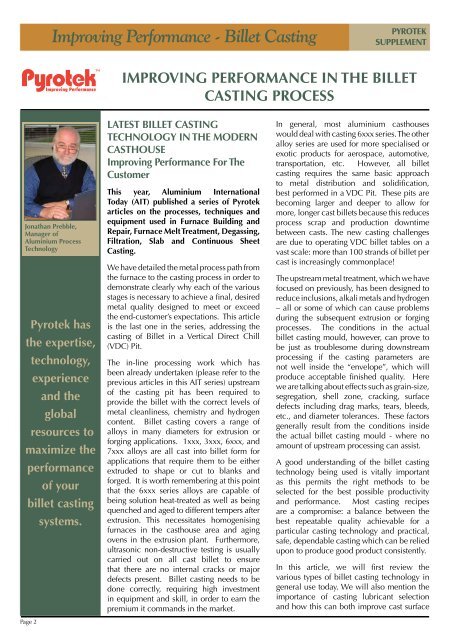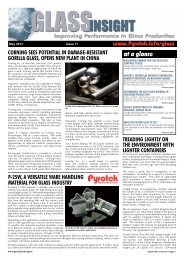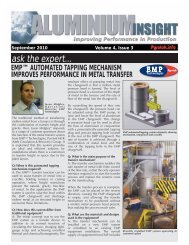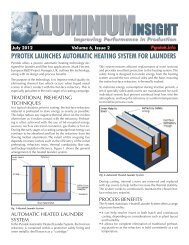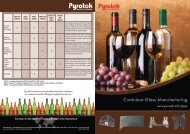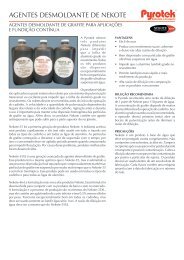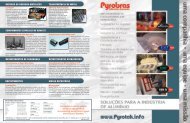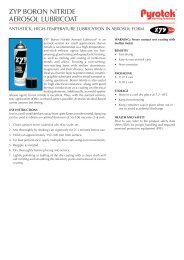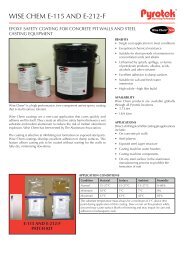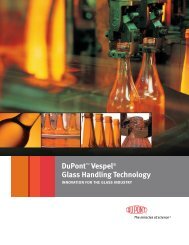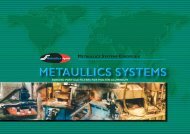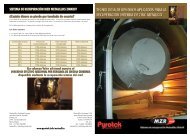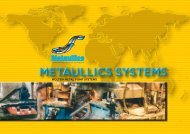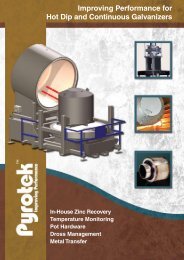Improving Performance - Billet Casting Improving ... - Pyrotek
Improving Performance - Billet Casting Improving ... - Pyrotek
Improving Performance - Billet Casting Improving ... - Pyrotek
Create successful ePaper yourself
Turn your PDF publications into a flip-book with our unique Google optimized e-Paper software.
<strong>Improving</strong> <strong>Performance</strong> - <strong>Billet</strong> <strong>Casting</strong><br />
Jonathan Prebble,<br />
Manager of<br />
Aluminium Process<br />
Technology<br />
<strong>Pyrotek</strong> has<br />
the expertise,<br />
technology,<br />
experience<br />
and the<br />
global<br />
resources to<br />
maximize the<br />
performance<br />
of your<br />
billet casting<br />
systems.<br />
Page 2<br />
LATEST BiLLET CASTing<br />
TECHnOLOgY in THE MODERn<br />
CASTHOUSE<br />
improving <strong>Performance</strong> For The<br />
Customer<br />
This year, Aluminium international<br />
Today (AiT) published a series of <strong>Pyrotek</strong><br />
articles on the processes, techniques and<br />
equipment used in Furnace Building and<br />
Repair, Furnace Melt Treatment, Degassing,<br />
Filtration, Slab and Continuous Sheet<br />
<strong>Casting</strong>.<br />
We have detailed the metal process path from<br />
the furnace to the casting process in order to<br />
demonstrate clearly why each of the various<br />
stages is necessary to achieve a final, desired<br />
metal quality designed to meet or exceed<br />
the end-customer’s expectations. This article<br />
is the last one in the series, addressing the<br />
casting of <strong>Billet</strong> in a Vertical Direct Chill<br />
(VDC) Pit.<br />
The in-line processing work which has<br />
been already undertaken (please refer to the<br />
previous articles in this AIT series) upstream<br />
of the casting pit has been required to<br />
provide the billet with the correct levels of<br />
metal cleanliness, chemistry and hydrogen<br />
content. <strong>Billet</strong> casting covers a range of<br />
alloys in many diameters for extrusion or<br />
forging applications. 1xxx, 3xxx, 6xxx, and<br />
7xxx alloys are all cast into billet form for<br />
applications that require them to be either<br />
extruded to shape or cut to blanks and<br />
forged. It is worth remembering at this point<br />
that the 6xxx series alloys are capable of<br />
being solution heat-treated as well as being<br />
quenched and aged to different tempers after<br />
extrusion. This necessitates homogenising<br />
furnaces in the casthouse area and aging<br />
ovens in the extrusion plant. Furthermore,<br />
ultrasonic non-destructive testing is usually<br />
carried out on all cast billet to ensure<br />
that there are no internal cracks or major<br />
defects present. <strong>Billet</strong> casting needs to be<br />
done correctly, requiring high investment<br />
in equipment and skill, in order to earn the<br />
premium it commands in the market.<br />
pyrotek<br />
supplement<br />
iMPROVing PERFORMAnCE in THE BiLLET<br />
CASTing PROCESS<br />
In general, most aluminium casthouses<br />
would deal with casting 6xxx series.The other<br />
alloy series are used for more specialised or<br />
exotic products for aerospace, automotive,<br />
transportation, etc. However, all billet<br />
casting requires the same basic approach<br />
to metal distribution and solidification,<br />
best performed in a VDC Pit. These pits are<br />
becoming larger and deeper to allow for<br />
more, longer cast billets because this reduces<br />
process scrap and production downtime<br />
between casts. The new casting challenges<br />
are due to operating VDC billet tables on a<br />
vast scale: more than 100 strands of billet per<br />
cast is increasingly commonplace!<br />
The upstream metal treatment, which we have<br />
focused on previously, has been designed to<br />
reduce inclusions, alkali metals and hydrogen<br />
– all or some of which can cause problems<br />
during the subsequent extrusion or forging<br />
processes. The conditions in the actual<br />
billet casting mould, however, can prove to<br />
be just as troublesome during downstream<br />
processing if the casting parameters are<br />
not well inside the “envelope”, which will<br />
produce acceptable finished quality. Here<br />
we are talking about effects such as grain-size,<br />
segregation, shell zone, cracking, surface<br />
defects including drag marks, tears, bleeds,<br />
etc., and diameter tolerances. These factors<br />
generally result from the conditions inside<br />
the actual billet casting mould - where no<br />
amount of upstream processing can assist.<br />
A good understanding of the billet casting<br />
technology being used is vitally important<br />
as this permits the right methods to be<br />
selected for the best possible productivity<br />
and performance. Most casting recipes<br />
are a compromise: a balance between the<br />
best repeatable quality achievable for a<br />
particular casting technology and practical,<br />
safe, dependable casting which can be relied<br />
upon to produce good product consistently.<br />
In this article, we will first review the<br />
various types of billet casting technology in<br />
general use today. We will also mention the<br />
importance of casting lubricant selection<br />
and how this can both improve cast surface


